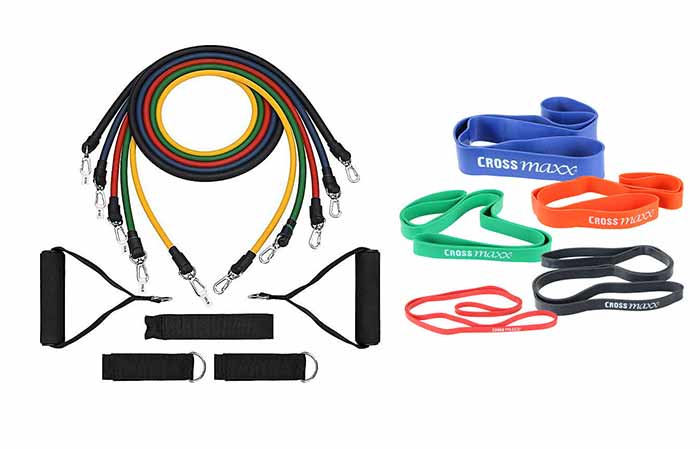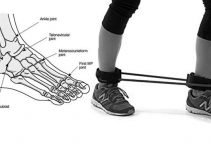The age-old debate between weights and resistance bands never seems to end. It has gone as far as involving scientific research into which workout method is the better of the two. The focus has been about which method helps you attain results faster, safer and cheaper.
Even after combining the results from these studies and carrying out interviews with people who’ve had experience with both exercise equipment, the answer remains largely subjective. Whether weights or resistance bands are better at attaining results depends on the user and their specific circumstances. Weights are better if you have access to a gym while bands are generally the more flexible and cheaper of the two. Following are the differences, similarities and which is better for what.
Resistance Bands vs Free Weights: Differences
Following is how these two workout methods are different
Bands and Weights
The most obvious differences come from how they’re made and price
Construction and Composition
Resistance bands are basically elastic stretchable bands made from elastics and rubber. Bands come in different sizes, widths, lengths, and resistance levels.

Weights are generally made from iron, steel or a mixture, and sometimes use water or sand as a basis for weight. Some are also coated with rubber. Just like bands, weights come in all varieties.

Cost
Based on the materials and time it takes construct, free weights cost more than bands.
Portability
Bands are lightweight. You can take them anywhere and use the in almost any place. Weights are of course heavy. You will need some space for most of the free weight exercise.
Durability
Basing on the construction materials and process, free weight last longer compared to resistance bands…pretty obvious!
Differences in Workouts
Constant Tension Through Range of Motion
Owing to the fact that most free weights rely on the force of gravity, you get no resistance once you get to the top of range of motion or at the peak contraction of muscle.
Bands offer constant tension all through even to the peak
Use of Momentum
Free weights allow use of momentum/swinging. It is commonly referred to as cheating and it may result to injuries.
Bands force you perform every exercise stiff as a board without swinging to complete a rep.
Variable Resistance
With bands the resistance is not fixed. The further you stretch the harder it becomes to pull. Free weights have fixed resistance. The weight will always remain the same no matter the position.
Resistance in Multiple Directions
Free weight work in a single plane: the vertical plane which is basically resisting gravity.
Bands offer multiple directions.
Replicability
It is possible to do a lot of weight-reliant exercises with other objects around the house, whereas resistance band style workouts are almost impossible to replicate without the bands.
Similarities
Following is how band and weight exercises are similar.
Progressive overload
Both free weights and bands offer progressive overload. Bands come in different resistances just as weights (dumbbells, discs etc.) come in different weights. For free weight all you need is the increase the weight and for bands all you need is to stack a couple of them together or use thicker bands that have are built with more resistance.
Muscle Building & Rehabilitation
Bands and weights both can help build muscle and they both can facilitate recovery.
Free Range of motion
Most experienced gym enthusiasts prefer free weights to machines. Reason is, free weights offer a free range of movement. In fact, bands offer even more free range of movement.
Time Under Tension
Both resistance bands and free weight allow you determine time under tension for each rep. In other words, you can control the rep speed.
Stretching
Most people think bands when it comes to stretching but including an appropriate amount of weight can take your stretches to another level.
Why Weights are Better
When comparing weights to resistance bands, weights have the following advantages:
1. Resistance Control
When going for resistance bands, you have various options among them the amount of resistance the band has. To increase the resistance of the band, you have to combine a few of them. You can also go for thicker or shorter bands for higher resistance. While this is great for growing muscles beyond your current level, you’re not able to know exactly how much more resistance you’re creating with the bands.
With free weights such as barbells or dumbbells, you know exactly how much more you’re able to lift as they’re labeled and all you need to do is add or remove the weights to attain the goals desired.
Weights are also easy to keep track of as you know just how much you used last time and how much more you’re comfortable with at the moment. With bands, adding another band of similar resistance to the original one may present more resistance than your body is comfortable with.
2. Variety
With weights, you have many varieties to choose from including dumbbells, barbells, kettlebells and many others. Also, each category has various ramifications to work on various parts of your body and at various levels of resistance.
Even for a single part of the body such as the biceps, you have many varieties to pick from and all can be made better and more effective with weights.
Even better, you can combine weight exercises with most workouts such as martial arts to gain speed and power. For example, some dumbbells can be held in the hands to make punching harder and hence build power in the arms.
3. Universality
There’s no gym that doesn’t have weights. That’s true no matter what country or location you go to.
You thus have a standard way of working out no matter your location. You can switch from your home gym to the gym down the street and the gym in a hotel halfway around the world and you’ll still find the weights you want.
This is helpful in keeping your progress in order. For example, if you know you can bench press 150 pounds, you’ll be able to do the same even if you were not in your home gym. Your workout progress can thus not be hampered by a change in location.
This point also hinges on the fact that gym shops always have what you want given that weights are universal in nature. It also overcomes the fact that some countries use different weight metrics from others. Most weights are written in both kilograms and pounds for uniformity.
It’s also the reason why there are sports created around weightlifting. It’s because each of the competitors has access to the same types of weights no matter their location.
With bands, however, you can’t tell the exact amount of resistance they have as they’re not always labeled. As such, you have to carry your own or buy an exact one if you’re away from yours.
4. Longevity
The issue of longevity is one that can’t be debated when it comes to deciding between resistance bands and weights. If you bought a set of weights a decade ago, chances are high that they’re still in pristine condition unless you grossly mistreat them (tough given their metal nature).
Weights need a simple wiping a few times a month and to be kept dry to last you a lifetime. They won’t even lose their weight amount even after decades of use in a gym.
With resistance bands, the fact that they’re made of rubber makes them quite vulnerable to breakage and generally becoming unusable overtime. If you bought a band five years ago, chances are high that it’s not the same band in terms of resistance and quality.
You can abuse a weight as much as you want. Drop it on the ground, hit it against other weights and so on and you’ll still have it in good condition (although you don’t need to do that). With resistance bands, you leave it out on the sun for too long and you have rigid rubber ready to break when stretched.
Why Bands are Better
Saying weights are used universally doesn’t mean bands aren’t. There are many types of bands all over the world and most gyms have a large number of them for those who wish to use them. Their advantages include the following:
1. Low Cost
A single resistance band, which can be put to lots of different uses, can cost as low as $30. The benefits of such a band go way beyond what you have been made to think. With a single band, you can stretch, build muscle, increase your range of motion, help your body heal and many others. This is great if you need to be fit yet don’t have all the cash to splash on a gym membership.
If you need to set up a home gym, you’ll need a separate room for the gym then start stocking it. A small gym with weights can be thousands of dollars in value. If, for example, you’re buying dumbbells, you can’t buy a single one. Rather, you’ll need a set of them at different weights to complete a set.
In general, while a dumbbell will last longer than a resistance band, you’ll do more with a resistance band than the dumbbell within the same period of time. Keep in mind that the band will cost much less even after buying a few of them over the same period.
To get access to a full set of weight exercises, you’ll need an expensive gym membership. With a band, you can use the little space there is in your bedroom for working out.
2. Weightless Muscle Building
While a lot of people erroneously think bands can’t build muscle, they’re quite effective at that. In fact, you’ll do more with a band to build specific muscles than with weights. For example, if you’re to use 30-pound weights to build the bicep muscles, the number of reps you can perform out of it will on average be less than what you’ll get from a 30-pound resistance band for the same exercise.
As such, the bands are just as effective as their weight counterparts or even better given the other advantages on this list. For example, if you’re buying a set of weights from 5 pounds to 50 pounds and doing the same for the resistance bands, the bands will save you a lot.
3. Stretching and Recovery
Though light weights can be used for stretches and recovery, any injured part of your body, resistance bands are way ahead of weights. In fact, your doctor will likely tell you to stay away from weights until, for example, that shoulder is fully healed.
Bands can help increase your range of motion during recovery and general stretching as part of a warmup. If the body isn’t stretched during recovery, you may suffer from a shortened ankle or other body part.
The same is true when you start lifting weights or punching the gym bag without stretching. The major result is that you’ll have a higher chance of injury than if you stretched.
In some sports such as wrestling or mixed martial arts, stretching is of paramount importance as it may determine just how long you stay in a fight. Most submission maneuvers are based on stretching a joint just beyond what you can withstand. If you did your stretches well, you have a higher chance of staying in the fight.
4. Safety
One of the reasons resistance bands are largely favored over free weights is that they’re safe. Whether you’re recovering from an injury, starting off a workout routine or simply warming up, a resistance band is the safest way to increase your fitness without injury.
First, the free nature of weights means that, if it goes beyond your range of motion, you’re likely to be injured as they respond more to gravity than your ability to keep them in line. With a band, you work against the resistance and you can easily manage how far it goes.
Secondly, free weight workouts can easily damage your back or other delicate body part such as the joints when not correctly. In lifting weights, weights can easily fall outside the designated range of motion leading to injury. Bands are easy to keep in line as they’re often anchored.
5. Flexibility
The largest benefit you get with resistance bands is flexibility when compared to weights.
First, you can move with your bands anywhere. Try that with dumbbells when all you have is your backpack and you’ll regret the whole idea. Given that most exercises only need a single exercise band, you can have each of your most used bags have a band for convenience. The fact that you’ll need at least a pair of weights to work out gives bands the overall win in this category.
Secondly, bands can be used to work almost all parts of the body. A dumbbell, for example, can do very little for the legs. A single band can be used to work the arms, back, legs, neck, chest and just about any part of the body you have a focus on.
Thirdly, resistance bands can be used just about anywhere. The park, bedroom, living room, backyard and the gym are just a few of the places you can take out your band and get fit. Weights need to be used in specific settings.
Verdict
The choice of whether you’re going for weights or resistance bands is highly subjective.
It will depend on your level of fitness, your exercise goals, your budget and many other aspects. In our opinion, however, exercise bands are the better option as they appeal to a larger pool of people.
If you have an active gym membership and are considering switching fully to resistance bands, the advice is not to switch over unless you have concrete reasons as explained in the above sections.
The same case applies to if you’ve been using bands and are considering the gym. Unless the reasons in support of a gym workout appeal to you, do not switch.
If, on the other hand, you’re looking for a way to start working out, we advice starting off with bands and, if your schedule and budget allows it, advance to weights under guidance.
If you have access to both and can afford them, use both as they can highly complement each other. You can enjoy the accuracy of resistance bands while incorporating the safety of resistance bands in the gym.
Further Reading
- Resistance Bands Basics: Meaning, Types, how they Work + Benefits
- Best Beginner Resistance Band Exercises
- Resistance Band Exercises for Knees
- Dead Lift Resistance Band Exercises
- Pilates Resistance Band Exercises
- Best Ankle Resistance Band Exercises
- Best Senior Seated Band Exercises
- Best Shoulder Resistance Band Exercises
- Chest Resistance Band Exercises for Men
- Glute/Butt Resistance Band Exercises for Women
- Upper and Lower Back Band Exercises
- Resistance Band Exercises for Arms(Biceps & Triceps)
- Best Resistance Band Abs Exercises
- Best Resistance Band Leg Exercises


